Introduction
Physiotherapy in West Vancouver for Foot
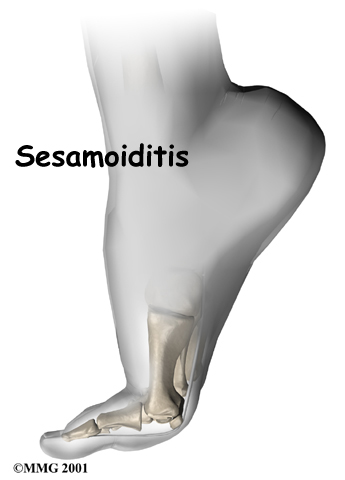
Welcome to West Vancouver Sports and Orthopedic Physiotherapy's patient resource in West Vancouver about Sesamoid Problems.
Two pea-sized bones, called sesamoids, are embedded within the soft tissues under the main joint of the big toe. Even though they are small in size, the sesamoids play an important role in how the foot and big toe work. If the sesamoids are injured, they can be a source of severe pain and disability.
This article will help you understand:
- how the sesamoid bones in the foot work
- how sesamoiditis develops
- what can be done for the condition
#testimonialslist|kind:all|display:slider|orderby:type|filter_utags_names:Foot therapy|limit:15|heading:Hear from some of our *Foot Therapy* patients#
Anatomy
Where are the sesamoids, and what do they do?
The main joint of the big toe forms the inside edge of the ball of the foot. The two small are located on the underside of this joint. There is of the base of the big toe.
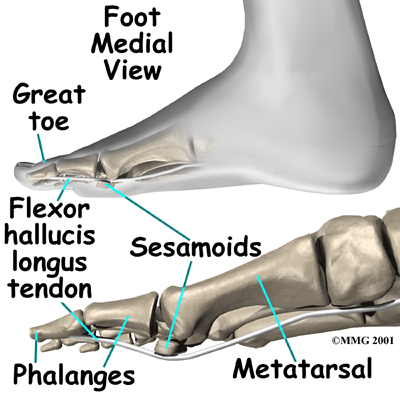
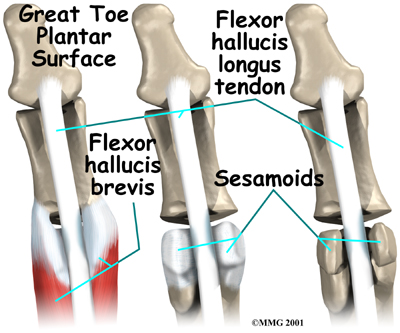
The muscles that bend the big toe down (the toe flexors) pass underneath the main joint of the big toe, crossing over the bump formed by the sesamoid bones. This bump acts as a fulcrum point for the toe flexors, giving these muscles extra leverage and power. The sesamoids also help absorb pressure under the foot during standing and walking, and they ease friction in the soft tissues under the toe joint when the big toe moves.
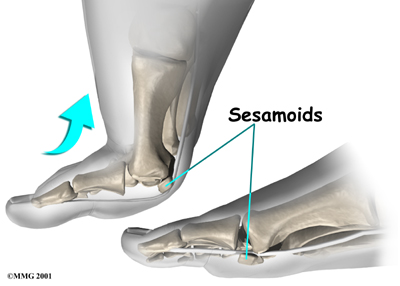
Related Document: West Vancouver Sports and Orthopedic Physiotherapy's Guide to Foot Anatomy
Causes
How does sesamoiditis develop?
Sesamoid pain can develop a number of different ways. When the tissues around the sesamoid bones become inflamed, doctors call the condition sesamoiditis. Sesamoiditis is often caused by doing the same types of toe movements over and over again, which happens in activities like running and dancing.
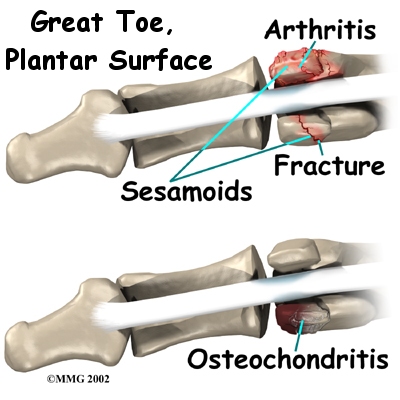 Fractures can also cause pain in the sesamoids. Fractures can occur when a person falls and lands bluntly on the ball of the foot. Stress fractures can also occur in the sesamoid bones. Stress fractures are usually caused by the strain of overworking the soft tissues. Athletes most often suffer stress fractures of the sesamoids because of the heavy and repeated demands that training places on the soft tissues of the foot and big toe.
Fractures can also cause pain in the sesamoids. Fractures can occur when a person falls and lands bluntly on the ball of the foot. Stress fractures can also occur in the sesamoid bones. Stress fractures are usually caused by the strain of overworking the soft tissues. Athletes most often suffer stress fractures of the sesamoids because of the heavy and repeated demands that training places on the soft tissues of the foot and big toe.
Arthritis can develop where the sesamoids glide under the bone of the big toe. The sesamoid bones create a joint where they move against the bone of the big toe. Like other joints in the body, this joint can also develop arthritis. Arthritis is more likely to be a problem in people who have high arches in their feet. The high arch causes the main joint of the big toe to become rigid. This focuses strain and pressure on the sesamoids.
In some cases, blood supply to the sesamoid bone is decreased. This condition is called . Osteochondritis causes a piece of the bone to actually die. The body's attempts to heal the area may build up extra calcium around the dead spot.
Sometimes sesamoid pain comes from extra tissue under the big toe joint, similar to a corn. Doctors call this extra tissue an intractable .
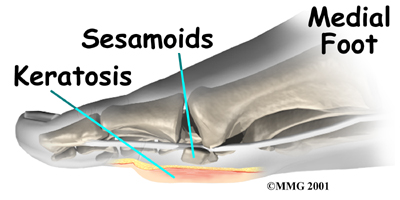
Symptoms
What does sesamoiditis feel like?
People with sesamoid problems usually feel vague pain under the main joint of the big toe. The sesamoids typically feel tender when touched. Movement of the big toe is often limited. People tend to notice pain mostly when their big toe is , which can happen when the back foot pushes off for the next step. Occasionally the joint catches or pops. The catching or popping is often followed by increased pain, which usually eases after resting. Some people report feelings of numbness in the web of the first two toes.
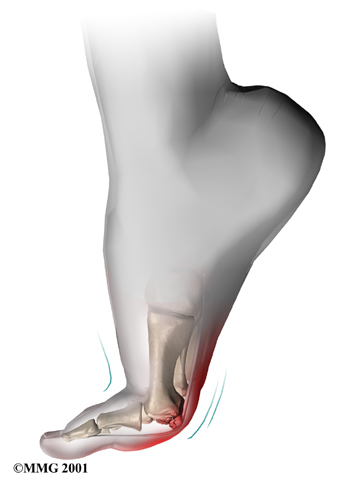
Diagnosis
How do health care providers identify this problem?
When you first visit West Vancouver Sports and Orthopedic Physiotherapy, our physiotherapist will ask many questions about your medical history. We’ll ask you about your current symptoms and whether you've had other foot and joint problems in the past. Our physiotherapist will then examine your painful toe by feeling it and moving it. This may hurt, but it is important that we locate the source of the pain and determine how well the toe is moving. You may also be asked to walk back and forth.
Some patients may be referred to a doctor for further diagnosis. Once your diagnostic examination is complete, the physiotherapists at West Vancouver Sports and Orthopedic Physiotherapy have treatment options that will help speed your recovery, so that you can more quickly return to your active lifestyle.
Our Treatment
What can be done for the condition?
Many cases of sesamoiditis can heal completely with careful treatment. There are two methods for treating sesamoid problems, nonsurgical treatment and surgery. Surgery is most often used as a last resort, when other forms of treatment aren't helping.
Non-surgical Rehabilitation
Although each patient recovers at a different rate, as a general rule, our patients with sesamoid problems typically undergo four to six physiotherapy treatments. Your physiotherapist can offer ideas of pads or cushions that help take pressure off the sesamoid bones. We may recommend that special padding in the shape of a J can be placed inside your shoe to ease pressure on the sesamoids as you stand and walk. You may need to limit the amount of weight placed on your foot when you're up and about. Shoes with low heels may also ease the pressure. Your doctor may also recommend supplementing rehabilitation with nonsteroidal anti-inflammatory drugs (NSAIDs), such as aspirin and ibuprofen.
Our physiotherapist may apply treatments to the painful area to help control pain and swelling, such as ultrasound, moist heat, and soft-tissue massage. Our physiotherapy sessions sometimes include iontophoresis, which uses a mild electrical current to push anti-inflammatory drugs, prescribed by your doctor, into the sore area.
If simple modifications are made to your shoes you may be allowed to resume normal walking immediately, but you should probably cut back on more vigorous activities for several weeks to allow the inflammation and pain to subside. If we must use more aggressive treatment during your recovery, you may be required to use crutches for several weeks to keep weight off the foot.
Post-surgical Rehabilitation
After a surgical procedure to shave or remove bone, patients are generally placed in either a rigid-soled shoe or a cast for two to three weeks. We will help you learn to properly use crutches to limit the weight that you put on your foot during the early stages of your recovery.
Treatment is more cautious after bone graft surgery. Patients usually wear a cast for up to four weeks. Then they wear a short walking cast for another two months, at which time active exercises can start.
The physiotherapists at West Vancouver Sports and Orthopedic Physiotherapy can develop a personalized physiotherapy program to help speed your rehabilitation. When your recovery is well under way, regular visits to West Vancouver Sports and Orthopedic Physiotherapy will end. Although we will continue to be a resource, you will eventually be in charge of doing your exercises as part of an ongoing home program.
West Vancouver Sports and Orthopedic Physiotherapy provides services for physiotherapy in West Vancouver.
Surgery
If surgery becomes necessary, several procedures are available to treat sesamoid problems. Which one your surgeon chooses will depend on your specific condition.
Bone Removal
Your surgeon may recommend removing part or all of the sesamoid bone. When bone is removed from only one sesamoid, the other sesamoid bone can still provide a fulcrum point for the toe flexors. However, if both of the bones are taken out, the toe flexors lose necessary leverage and can't function. When this happens, the big toe will either bend up like a claw or slant severely toward the second toe. Thus, surgeons usually try to avoid taking both sesamoids out.
When a sesamoid bone is fractured in a sudden injury, surgery may be done to remove the broken pieces. To remove the sesamoid on the inside edge of the foot, an incision is made along the side of the big toe. The soft tissue is separated, taking care not to damage the nerve that runs along the inside edge of the big toe. The soft tissues enclosing the sesamoid are opened, and bone is removed. The tissues next to the sesamoid are stitched up. Then the soft tissues are laid back in place, and the skin is sewed together.
Surgery is similar for the sesamoid closer to the middle of the foot. The only difference is that the surgeon makes the incision either on the bottom of the big toe or in the web space between the big toe and the second toe.
Scraping
For patients diagnosed with stubborn plantar keratosis, surgeons generally perform surgery to scrape off the extra tissue. Your surgeon may decide to shave off only the affected part of the bone. The bottom half of the sesamoid is cut off, and the rough edges of the remaining part of the bone are filed with a special tool to leave a smooth shell. This surgery is easier on the body than procedures that completely remove the sesamoid.
Bone Graft
When patients continue to have problems with nonunion stress fractures, a bone graft may help the parts of the bone heal together. Surgeons mostly use this type of surgery for high performance athletes to keep the fulcrum point intact. The surgeon makes an incision along the inside edge of the main joint of the big toe. This exposes the sesamoid bone. The surgeon gathers small bits of bone from a nearby part of the big toe bone. The bone fragments are then packed into the unhealed area of the sesamoid. The soft tissue surrounding the sesamoid is stitched closed. Then the soft tissues are laid back in place, and the skin is sutured together.
Portions of this document copyright MMG, LLC.









 Fractures can also cause pain in the sesamoids. Fractures can occur when a person falls and lands bluntly on the ball of the foot. Stress fractures can also occur in the sesamoid bones. Stress fractures are usually caused by the strain of overworking the soft tissues. Athletes most often suffer stress fractures of the sesamoids because of the heavy and repeated demands that training places on the soft tissues of the foot and big toe.
Fractures can also cause pain in the sesamoids. Fractures can occur when a person falls and lands bluntly on the ball of the foot. Stress fractures can also occur in the sesamoid bones. Stress fractures are usually caused by the strain of overworking the soft tissues. Athletes most often suffer stress fractures of the sesamoids because of the heavy and repeated demands that training places on the soft tissues of the foot and big toe.
